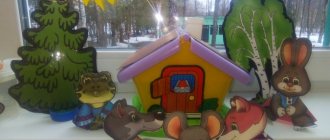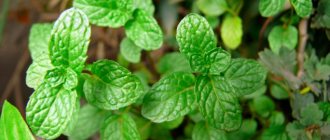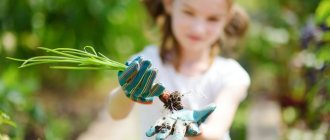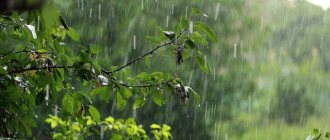Cognitive and research project “Invisible Air” in the senior group.
Educator: Take a plastic bag. What's in it?
Children: It's empty.
Educator: It can be folded several times. Look how thin he is. Now we fill the bag with air and twist it. The bag is full of air, it looks like a pillow. The air took up all the space in the bag. Now let's untie the bag and let the air out of it. The package became thin again. Why?
Children: There is no air in it.
Educator: Look, Kuzya! Conclusion: the air is transparent, to see it, you need to catch it. And we were able to do it! We caught the air and locked it in a bag, and then released it.
Kuzya: This bag reminded me of something! In the summer I saw people using such “locked” air! On the river! It looked like it was an air mattress! I also saw children wearing lifeguards and even a lifebuoy!
Educator: Of course, Kuzya! After all, air is lighter than water! And if there is air inside the mattress, then, of course, it floats!
Kuzya: So, if there is air inside something, it will float? Guys, help me sort out the toys: which ones will float and which ones won’t? Where did the air hide?
Didactic game “Where is the air hidden?”
(children take turns taking toys from Cousin’s chest and laying them out on 2 trays)
Educator: Well done, guys! Help Kuza! Now you know, Kuzya, that objects with air inside will float. But be careful, if water gets in and air is pushed out, the item may sink.
Kuzya: Now I know: inside objects, where it seems empty, there is air hidden there. But I wonder, is there air inside a person?
Educator: What do you think, guys? Let's check?
Experiment 2. Blow into a tube placed in a glass of water.
Educator: Blow into a tube placed in a glass of water. What's happening?
Children: Bubbles come out.
Educator: You see! Conclusion: this means there is air inside us. We blow into the tube and he comes out. But in order to blow more, we first inhale new air, and then exhale through the tube and we get bubbles. Guys, what other bubbles can you blow?
Children: Soapy.
Educator: Let's blow soap bubbles too.
F/m “Soap Bubbles” (to music)
Educator: Kuzya, what do you think is inside the soap bubbles?
Kuzya: Of course, soap!
Educator: Guys, is Kuzya right? Why? Of course, each bubble contains air inside. This soap film is filled with air and comes off the loop. Lungs filled with air bubbles float in the air.
Kuzya: I see! You exhale. It means it is inside you. But how does it get to you? Through the nose?
Educator: Of course! All people breathe through their nose. Guys, let's show Kuza how our noses breathe. When we simply inhale and exhale air, do we see it?
Short-term project “Air around us”
Municipal budgetary preschool educational institution
Kindergarten “Zvezdochka” in the city of Zernograd
SHORT-TERM PROJECT IN THE PREPARATORY GROUP “POCHEMUCHKI”
"The Air Around Us"
Short-term project in the preparatory group “Pochemuchki” “The air around us”
Project type:
short-term, group.
Project type
: information and research, educational.
Project implementation timeline:
1 month
Project participants:
teachers, children, parents.
Children's age:
6 - 7 years old.
Relevance
Air is a magician who is capable of performing many miracles. It can lift a sunken ship from the seabed, make possible the smooth flight of an airship and the rapid movement of aircraft.
The preschooler has lived in the world for several years and is accustomed to encountering air everywhere. But a child is not yet able to learn on his own, to study its properties, to find out what he had not thought about before or had no idea about. Adults are accustomed to transmitting knowledge to children mainly through their eyes and ears. But if they passed through hands, through activity, then we could give every child joyful surprise, inquisitive analysis, the first inspiring success of a natural scientist. To develop the child's attention, thinking, speech. Our task is to awaken interest in the world around us, to develop the ability to make discoveries and get carried away. Currently, in connection with the revision of priority forms and methods of teaching in preschool education, it is precisely the methods that develop children’s abilities for initial forms of generalization, inference, and abstraction that predominate. And this method is experimentation.
The relevance of the chosen topic of the project is also in the fact that people do not take care of what they have, because every year more than a million tons of harmful substances are released into the air, which have a detrimental effect on the life of the entire living world.
Problem
Children do not have enough knowledge about air. People, animals and plants breathe air. Air is everywhere. How can you see it? How to prove that it exists? What is air? Why do people and other living organisms need it? What is the meaning of air? How does air get polluted? How to protect the air? Such questions arose from the children during a conversation about air.
Search for forms of answering the questions asked
1.Work with methodological and fiction literature.
2.Development of activity content and preparation of resources for conducting research, experiments, experiments with air, didactic games, and classes.
Objective of the project:
Create conditions for the development of children’s cognitive and research abilities during the project; to form in children knowledge about the importance of air in the life of all living things on earth.
Project objectives for children
- Introduce children to the concept of “air”.
- To form children's knowledge about the properties of air: transparent, invisible, can move, necessary for all living things to live.
- To develop cognitive interest in experimentation through involving them in conducting experiments.
- Replenish the children's vocabulary with the words: moves, inflated, deflated, invisible, transmits a smell.
- Develop a desire to find ways to solve a problem.
- Cultivate observation and curiosity.
Tasks for the teacher
1. Select and study methodological literature and Internet resources on the topic of the project.
2. Select didactic games, experiments, GCD notes and video materials about the properties and use of air.
3. Contribute to the consolidation of parent-child relationships and improve contact between preschool employees and parents.
4. Motivate parents to participate in the implementation of the project “Get acquainted - this is air!”
Tasks for parents:
1.Improve mutual understanding with your baby. Activate and enrich the educational skills of parents, confidence in their own pedagogical capabilities.
2. Stimulate children’s desire to learn new things about inanimate nature.
3. Provide an atmosphere of goodwill and comfort in child-parent communication.
Expected results:
- Increase the level of development of children's curiosity.
- Children should gain a basic understanding of air and its properties.
- Children should receive the simplest knowledge about experiments with which they can get acquainted with air.
- Development of children's communication skills and the ability to work in a team.
- Increasing the pedagogical literacy of parents. Involving parents in cooperation, acquiring knowledge on organizing educational and research activities on the topic “Air”.
Expected result
- Presentation of work experience in the form of a presentation.
- Organization of the photo exhibition “Air and Us”.
- Creation of the album “The Air Around Us”
- Organization of the group museum “Invisible Air”
- Video “Everyone needs air”
As a result of the project, children will know
- Where is the air?
- The role of air in human life.
- The role of air in the life of animals.
- The role of air in plant life.
- What is air needed for?
- Properties of air.
- Air purification methods.
- Rules for the young researcher.
As a result of the project, children will be able to
- Perform actions to organize experiments with air.
- Ask questions, look for answers.
- See a problem on a specific topic.
- Formulate a goal, plan tasks.
- Make hypotheses and test them.
- Select tools and materials for independent activities.
- Conduct feasible experiments and draw appropriate conclusions.
- Present the results of experiments in the form of simple diagrams, signs, drawings.
Main directions of work
- Work with children.
- Working with parents.
- Working with employees.
- Work to improve the subject-development environment.
Project implementation mechanism
- Work with children
planned and carried out throughout the day, through all activities.
- Classes of direct educational activities (DED)
- Experimental activities of preschool children.
- Search and research activities.
- Organization of games: didactic, board-printed, verbal, creative, role-playing.
- Organization of labor activities.
- Organization of artistic and speech activities.
- Organization of visual activities.
- Looking at paintings and illustrations.
- Organization of walks and observations.
- Reading works of fiction.
- Conversations.
- Exhibition of children's drawings.
Project Implementation Plan
- stage.
Preparatory
- Drawing up a project.
- Study and analysis of the level of development of cognitive abilities in children,
skills and abilities of research activities and creative
design.
- Selection of methods, forms of work with children, parents of pupils,
- Creating an effective subject-development environment in the group, creating an information space for parents.
- Selection of children's fiction to read to children.
- Work with methodological material and literature on this topic.
- Consultation for parents to familiarize themselves with the topic, objectives of the project, and content of the work.
- Selection of visual and didactic material, fiction on the topic of the project.
- Examination of illustrations, plot paintings.
- Learning games.
- Learning the musical repertoire.
- Use of information and communication technologies
Main stage
Planning work with children
| No. | The content of the work | Resource support |
| 1 | Conversations, didactic games | Conversations: “How to hear the air”, “Noses are needed not only for beauty”, “Flying seeds”. D/I: “What kind of wind”, “Guess what tree these seeds are from”, “What’s extra?”, “What’s first, what’s next?” Labor, involve the children in washing the leaves of indoor plants. |
| 2 | Reading fiction | S. Marshak “Soap Bubbles”, I. Tokmakova “Windy, Windy”, N. Nekrasov “Mourning Wind”, S. Mikhalkov “Three Winds”, S. Zhupanin “I’ll Draw the Wind”, Tale “Southern Wind” by V.M. Garshin; Fairy tale “Frog - Traveler” V. Kataev; Russian folk tale “Bubble, Bast Shot and Straw” Poems about air and wind ( Appendix 1) Riddles, proverbs and sayings about air. ( Annex 1) Conversations “What is air”, “The importance of air for the life and growth of living organisms”, “Noses are needed not only for beauty”, “What benefits does the wind bring?” ( Appendix 4) |
| 3 | Cognitive and research activities | Watching the wind. Air research in different places: in a room, on the territory of a kindergarten, closer to the road, etc. GCD “Air and its role in human life” Game exercises “Feel the air”, “Guess the smell” Observation “Mysterious bubbles”. Experiments: “Air”, “Wind is the movement of air”, “Magic funnel”, “Leaky jar”, “Inflating a balloon”, “What’s in the bag?”, “Mysterious bubbles.” “Blowing Soap Bubbles”, “Rescue Bubbles”, “Battleship”. |
| 4 | Play activity | Games with various air-related toys: musical instruments, turntables, fans. Role-playing games “Travel on a sailing ship”, “Flying on an airplane”, “Travel in a hot air balloon”. |
| 5 | Artistic and aesthetic activities | Drawing with soap bubbles. Games with various constructors. Topic: "Airplane" Drawing “What is the air like?” |
| 6 | Interaction with parents: | Consultations “Teach children to love nature”, « We need clean air" “Improving the air with the help of plants” - recommendations for parents. |
Working with parents:
- Questioning.
- Design of folders - slides, folders - clamshells.
- Organization of joint activities: making attributes, games, homework.
- Making crosswords.
- Selection of artistic words, riddles.
- Exhibition of drawings.
- Exhibition of illustrations and photographs.
- Individual conversations.
Working with employees:
- Development of methodological materials within
Project results:
- Analysis of the work done, monitoring the level of development of children’s research skills, determining the level of competence of parents in organizing natural science observations and experiments with children at home, the desire to cooperate with preschool teachers.
- Implementation of assigned tasks, development of diagnostic, methodological, practical material, determination of the most effective methods and techniques for working with children, parents, kindergarten teachers in organizing natural scientific observations and experiments with children.
- Making a card index of entertaining experiments and experiments with air
- Creative presentation with the participation of children “Experiments with air.”
Summary of the open lesson “Air is invisible”
MKOU Toguchinsky district "Bugotakskaya secondary school"
Educator: Kazantseva Anna Yurievna
Summary of an open lesson in a mixed-age group “Air is invisible”
Integration of educational areas:
“Cognitive development”, “Speech development”, “Socio-communicative development”, “Physical development”.
Target:
Systematize children's knowledge about the properties of air, develop speech and cognitive activity, in the process of experimentation.
Tasks:
.
Help enrich and consolidate children's knowledge about the properties of air.
.
Expand children's understanding of the importance of air in human life.
.
Develop the ability to establish cause-and-effect relationships based on basic experimentation and draw conclusions.
.
Cultivate interest in research activities.
.
Introduce children to an unconventional
air painting technique - blotography
.
.
Activate speech activity.
.
Strengthen and expand children's vocabulary.
.
Develop the ability to independently solve a given problem.
.
Foster friendly relationships between children.
Materials and equipment:
plastic bags, toothpicks, paper fans, cups of water, cocktail straws, identification cards, containers with crushed foods (orange, garlic, onions), napkins, blindfolds according to the number of children, aprons according to the number of children, balloons, caps from felt-tip pens, audio recording, red and green signal cards, brushes, gouache pre-diluted with water, a sheet of paper.
Progress of educational activities:
Educator
: Guys, guests came to our lesson today. Let's say hello. (Greetings to the children).
(Children hold hands and stand in a circle.)
Let's join hands, friends!
Let's smile at each other.
We wish everyone well,
And let's say hello together!
Educator:
children, do you want me to tell you an amazing story? You already know that there are oceans on planet Earth. But there is another invisible ocean. We can dive into it, swim, and stay dry. What kind of ocean is this, don’t you know? Then guess the riddle: It goes through the nose into the chest and goes back on its way. It is invisible, but still we cannot live without it (Air)
Educator:
Well done boys. Do you think there is air in the kindergarten premises? (Children's answers).
Educator:
Today we will talk about air like real scientists - researchers. Scientists work in a room with many experimental instruments, but what is this room called? (Children's answers). That's right guys, laboratory. Today I organized a small laboratory for you in the group. Let's go to our laboratory to conduct experiments. We must be in special clothing, wear aprons. In the laboratory, certain rules must be followed:
. Maintain silence and do not interrupt each other.
. Do not taste the contents of the vessels.
. Do not touch anything on the tables without the permission of the supervisor.
. We listen very carefully.
. Work carefully.
Educator: guys, how can you catch air? (Children's answers).
EXPERIENCE No. 1.
“How to catch air?”
Educator
: Take plastic bags from the table and try to catch the air. “One, two, three, catch the air,” and we’ll twist the bags. What happened to the packages? (swollen). What's in them? (air).What is it like? (transparent). Do you see him? (No). Can you feel it? (No).
Educator:
Fine! Let's check. Take a sharp stick and carefully pierce the bag. Bring it to your face and press it with your hands. What do you feel? (a stream of air).
Educator
: How else can you feel the air? (children's answers).
Guys, there is a fan on the table, take it in your hands and wave it towards yourself. What do you feel? (breeze).
CONCLUSION
: You can feel the air.
Educator
: Do you know how you can see air? (children's answers).
EXPERIENCE No. 2.
"We see air"
Educator
: you need to take a straw, put one end in water, and blow on the other. (children inhale air and exhale into a tube). What do you see? (air bubbles). Blow into the tube strongly, and then weakly. What changed? (children's answers). In both cases were there the same number of bubbles? (No). Why? (children's answers).
CONCLUSION
: air mono see. When we exhale a lot and forcefully, there are a lot of bubbles. When we exhale less and weakly, there are few bubbles. Using a straw and a container of water, we saw air.
Educator:
Guys, can you hear the air? How can you hear? (children's answers). If we blow into the cap of a felt-tip pen, we will hear a sound. Take the lid and blow from the edge. What do you hear? (sound of air).
Now let's inflate the balloon. What do you think can be done with a balloon to hear the air? (children's answers), (we hear the squeak of air).
CONCLUSION
: air can be heard.
Physical education lesson: Invisible air, (hands up right and left) Go out for a walk! (“name”) Invisible air, (hands up right and left) How to catch you? (Clapping hands in different places) If I run quickly into the field, (they run in place) I’ll find clean, pure air! (Rub their hands) If I walk through the forest with my grandfather, (steps in place) I will find the most healthy air! (Hands crossed to shoulders) If I go to the mountains with my dad, (stretch up on tiptoes) I will find the most crystalline air! (“flashlights”)
Educator:
can you smell the air? (children's answers).
EXPERIENCE No. 3.
"Know by smell"
Educator: the air itself has no smell, but it can carry odors. By the smell, we can guess what our mother prepared for us in the kitchen. I invite each of you to feel the aromas (orange, onion, garlic) with your eyes closed. (Children take turns sniffing the container with the smell). You did great. Well done.
CONCLUSION:
clean air does not smell of anything, it smells only of the one whose smell is currently spreading.
Educator:
guys, do you think air has weight? (children's answers). We'll check this now. Are two balloons hanging on a wooden stick at the same level, that is, do they have the same weight? (children's answers), (Yes). The teacher pierced one balloon with a toothpick and it burst, that is, the air came out, it became lighter (higher than a balloon filled with air).
CONCLUSION:
air has weight.
Educator:
Guys, you can draw with air. This technique is called blotography. Want to try? (Yes).
Educator
: dip the brush in diluted paint and spray it onto a sheet of paper. The thicker the paint, the richer the color, but the more difficult it is to blow out. We take a tube and blow through it onto multi-colored drops of paint, they turn into blots. At the same time, the sheet of paper can be rotated - the blots turn out even more interesting! (children try to draw). Analysis of children's work.
Reflection
Educator:
Let's once again consolidate what we learned about air. I will say statements, and instead of answering you will show colored cards. A red card means no, and a green card means yes. Be careful!
-The air surrounds us on all sides. (Yes).
-The air is transparent, so we don’t see it (Yes).
-Air is heavier than water (no).
— A person can live without air (no).
-Wind is the movement of air (yes).
-Clean air has a smell (no).
Educator:
Well done guys did a great job. Guys, we did a lot of experiments today. Tell me, what experience did you like best? (children's answers). What new did you learn today? (children's answers), (blotography).
Educator:
our lesson has come to an end, you were all attentive and active. Children are given balloons as a gift.






